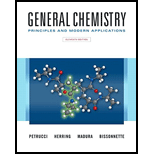
(a)
Interpretation:
To determine the chemical equation for the reaction where lithium carbonate gets decomposed.
Concept introduction:
A chemical equation refers to the symbolic representation of a given
(b)
Interpretation:
To determine the chemical equation for the reaction in which calcium carbonate reacts with hydrochloric acid.
Concept introduction:
A chemical equation refers to the symbolic representation of a given chemical reaction in the form of formulae and symbols where the product entities are present on the right hand side of the chemical equation while the reactant entities are present on the left hand side of the chemical equation.
(c)
Interpretation:
To determine the chemical equation for the reaction where Aluminum is made to react with sodium hydroxide.
Concept introduction:
A chemical equation refers to the symbolic representation of a given chemical reaction in the form of formulae and symbols where the product entities are present on the right hand side of the chemical equation while the reactant entities are present on the left hand side of the chemical equation.
(d)
Interpretation:
To determine the chemical equation for the reaction in which barium oxide reacts with water.
Concept introduction:
A chemical equation refers to the symbolic representation of a given chemical reaction in the form of formulae and symbols where the product entities are present on the right hand side of the chemical equation while the reactant entities are present on the left hand side of the chemical equation.
(e)
Interpretation:
To determine the chemical equation for the reaction in which sodium peroxide reacts with carbon dioxide gas.
Concept introduction:
A chemical equation refers to the symbolic representation of a given chemical reaction in the form of formulae and symbols where the product entities are present on the righthand side of the chemical equation while the reactant entities are present on the left hand side of the chemical equation.
Want to see the full answer?
Check out a sample textbook solution
Chapter 21 Solutions
EBK GENERAL CHEMISTRY
- Calculate the pH and the pOH of each of the following solutions at 25 °C for which the substances ionize completely: (a) 0.000259 M HClO4arrow_forwardWhat is the pH of a 1.0 L buffer made with 0.300 mol of HF (Ka = 6.8 × 10⁻⁴) and 0.200 mol of NaF to which 0.160 mol of NaOH were added?arrow_forwardDetermine if the following salt is neutral, acidic or basic. If acidic or basic, write the appropriate equilibrium equation for the acid or base that exists when the salt is dissolved in aqueous solution. If neutral, simply write only NR. Be sure to include the proper phases for all species within the reaction. NaN₃arrow_forward
- A. Draw the structure of each of the following alcohols. Then draw and name the product you would expect to produce by the oxidation of each. a. 4-Methyl-2-heptanol b. 3,4-Dimethyl-1-pentanol c. 4-Ethyl-2-heptanol d. 5,7-Dichloro-3-heptanolarrow_forwardWhat is the pH of a 1.0 L buffer made with 0.300 mol of HF (Ka = 6.8 × 10⁻⁴) and 0.200 mol of NaF to which 0.160 mol of NaOH were added?arrow_forwardCan I please get help with this.arrow_forward
- Determine if the following salt is neutral, acidic or basic. If acidic or basic, write the appropriate equilibrium equation for the acid or base that exists when the salt is dissolved in aqueous solution. If neutral, simply write only NR. Be sure to include the proper phases for all species within the reaction. N₂H₅ClO₄arrow_forwardPlease help me with identifying these.arrow_forwardCan I please get help with this?arrow_forward
 Chemistry & Chemical ReactivityChemistryISBN:9781337399074Author:John C. Kotz, Paul M. Treichel, John Townsend, David TreichelPublisher:Cengage Learning
Chemistry & Chemical ReactivityChemistryISBN:9781337399074Author:John C. Kotz, Paul M. Treichel, John Townsend, David TreichelPublisher:Cengage Learning Chemistry & Chemical ReactivityChemistryISBN:9781133949640Author:John C. Kotz, Paul M. Treichel, John Townsend, David TreichelPublisher:Cengage Learning
Chemistry & Chemical ReactivityChemistryISBN:9781133949640Author:John C. Kotz, Paul M. Treichel, John Townsend, David TreichelPublisher:Cengage Learning Chemistry: The Molecular ScienceChemistryISBN:9781285199047Author:John W. Moore, Conrad L. StanitskiPublisher:Cengage Learning
Chemistry: The Molecular ScienceChemistryISBN:9781285199047Author:John W. Moore, Conrad L. StanitskiPublisher:Cengage Learning


